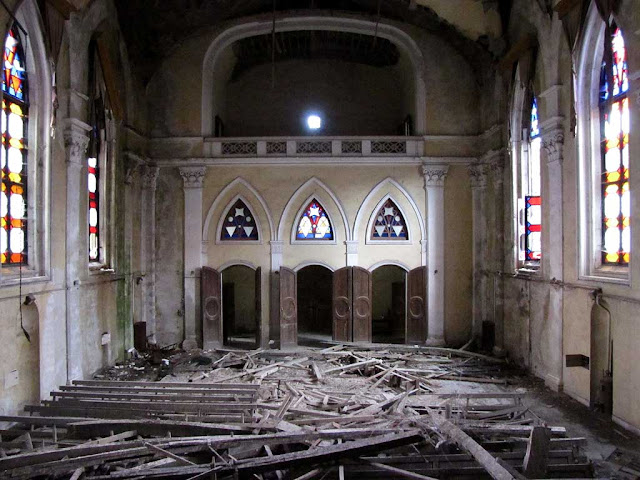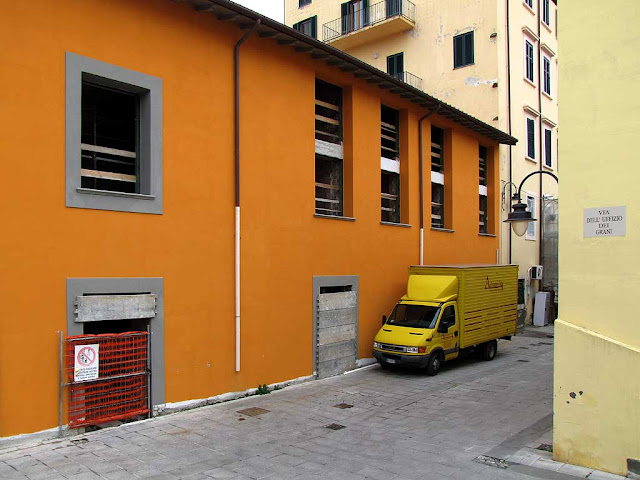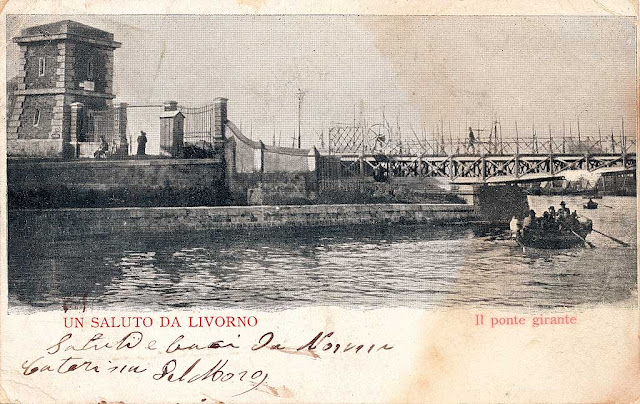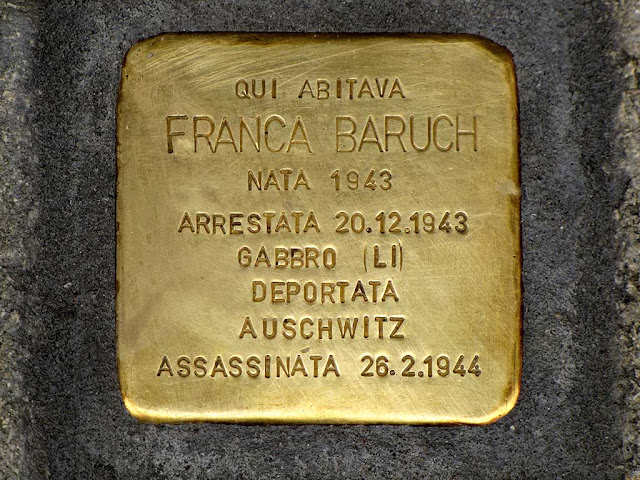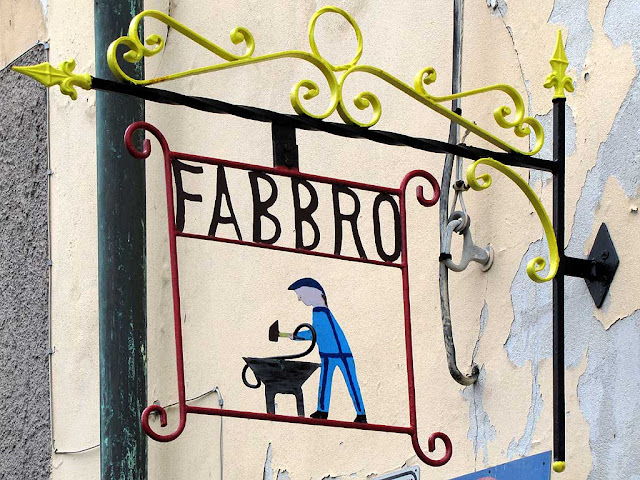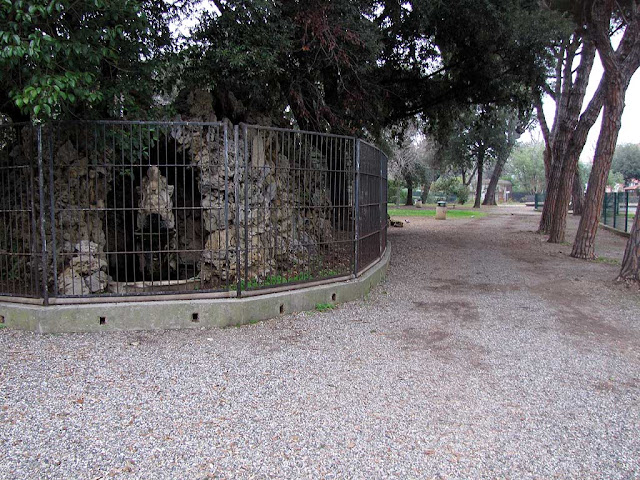Windows of adjacent buildings, Piazza Mazzini.
Thursday, February 28, 2013
Wednesday, February 27, 2013
On Board the Vespucci - 2 of 2
This is the second (and last) installation of a set of “rescued” pictures taken during a visit on board the Italian Navy training ship “Amerigo Vespucci”. Here is the ship's bell ...
... and a detail of what I think is a quite elegant capstan of sorts.
Search labels: Amerigo Vespucci
See also: Amerigo Vespucci - On Board - Elbow Grease - Going Aloft - Bye Bye Vespucci - Details - Around the Vespucci - Drawings - Welcome Home - Vespucci's Boats - Vespucci's Anchors - Navy and Stamps - 80 Years - Palinuro and Vespucci - Tall Ships Walk - Amerigo Vespucci: Vidhar - Two Months at Sea - Admirals on Board - Up There - Cristoforo Colombo - On Board the Vespucci - 1 of 2
External links: Italian training ship Amerigo Vespucci (Wikipedia)
... and a detail of what I think is a quite elegant capstan of sorts.
Search labels: Amerigo Vespucci
See also: Amerigo Vespucci - On Board - Elbow Grease - Going Aloft - Bye Bye Vespucci - Details - Around the Vespucci - Drawings - Welcome Home - Vespucci's Boats - Vespucci's Anchors - Navy and Stamps - 80 Years - Palinuro and Vespucci - Tall Ships Walk - Amerigo Vespucci: Vidhar - Two Months at Sea - Admirals on Board - Up There - Cristoforo Colombo - On Board the Vespucci - 1 of 2
External links: Italian training ship Amerigo Vespucci (Wikipedia)
Labels:
Amerigo Vespucci,
Livorno,
sailship
Tuesday, February 26, 2013
Palladian Flooring
Two different shades of Palladian flooring ...
... under the porticoes of Largo Duomo.
See also: Pavements
... under the porticoes of Largo Duomo.
See also: Pavements
Monday, February 25, 2013
Sea Monster
In the post Four Horses we were able to ascertain the prowess of the sculptor Pietro Tacca with horses, and we have not yet seen the last of it. He was also quite good at doing monsters of the sea variety, like this one on a fountain in our in Piazza Colonnella, at the west end of Via Grande.
Originally, the fountains (1629) should have been placed on the sides of the Four Moors, but the Grand Duke Ferdinando II liked them so much that kept them in Florence and had them erected by his ancestor's equestrian statue in Piazza della Santissima Annunziata (photo). We only got copies, after three centuries...
See also: Sea Monsters - Four Horses
External links: Pietro Tacca (Wikipedia)
Originally, the fountains (1629) should have been placed on the sides of the Four Moors, but the Grand Duke Ferdinando II liked them so much that kept them in Florence and had them erected by his ancestor's equestrian statue in Piazza della Santissima Annunziata (photo). We only got copies, after three centuries...
See also: Sea Monsters - Four Horses
External links: Pietro Tacca (Wikipedia)
Sunday, February 24, 2013
Via Magenta
Via Magenta, January 2013
Via Magenta, early 1900s
(The caption on the postcard is clearly wrong)
(The caption on the postcard is clearly wrong)
(Postcard digitized from the collection of Antonio Cantelli)
Search labels: postcardSee also: Santa Maria del Soccorso - Fallen
Saturday, February 23, 2013
Friday, February 22, 2013
The Ripper
July 2011: a wheelless bicycle abandoned against a parapet, Scali del Pesce.
May 2012: same modus operandi, Via Carlo Goldoni.
February 2013: Piazza della Vittoria, two more bike frames. Are we looking at a serial killer?
Search labels: bicycle art
External links: Bicycle Art
May 2012: same modus operandi, Via Carlo Goldoni.
February 2013: Piazza della Vittoria, two more bike frames. Are we looking at a serial killer?
Search labels: bicycle art
External links: Bicycle Art
Labels:
bicycle art,
Livorno
Thursday, February 21, 2013
Wednesday, February 20, 2013
Stella Polare
The “Stella Polare” (Pole Star) is 21-meter Bermudan yawl of the Italian Navy: here she is sailing just in front of the Terrazza Mascagni.
During her first participation in the 1966 Giraglia keelboat regatta, “Stella Polare” won the historic race and set a new record (243 miles in 29 hours) that stood for almost 20 years. In 1968 she also won a memorable 3850-miles Atlantic race from Hamilton (Bermuda) to Travemünde (Germany).
See also: Sun and Sea - Flags and Sails
External links: Stella Polare (Italian Navy)
During her first participation in the 1966 Giraglia keelboat regatta, “Stella Polare” won the historic race and set a new record (243 miles in 29 hours) that stood for almost 20 years. In 1968 she also won a memorable 3850-miles Atlantic race from Hamilton (Bermuda) to Travemünde (Germany).
See also: Sun and Sea - Flags and Sails
External links: Stella Polare (Italian Navy)
Tuesday, February 19, 2013
Cenci
“Cenci” are a traditional sweet crispy pastry made out of dough that has been shaped into thin twisted ribbons, deep-fried (tastier) or sometime baked (healthier) and generously sprinkled with powdered sugar.
The name means literally rags and it is used in this part of Tuscany, but I understand that you can find them almost everywhere under other funny and different names like “bugie” (lies) or “chiacchiere” (chit-chat). Here they are usually sold during the Carnival, mostly in bakeries, and one kg costs around 18 Euro.
External links: Angel wings
The name means literally rags and it is used in this part of Tuscany, but I understand that you can find them almost everywhere under other funny and different names like “bugie” (lies) or “chiacchiere” (chit-chat). Here they are usually sold during the Carnival, mostly in bakeries, and one kg costs around 18 Euro.
External links: Angel wings
Monday, February 18, 2013
Four Horses
Luckily none of these statues is in Livorno, or they would have already fallen to pieces, but most of them had something to do with our city. In 1587 Ferdinando I de' Medici commissioned to the sculptor Giambologna an equestrian statue of his father, Cosimo I de' Medici, the first Gran Duke of Tuscany.
The large bronze statue (1598), now in Piazza della Signoria, was the first equestrian sculpture in Florence. After the Romans, no surviving monumental equestrian bronze was cast in Europe until Donatello's statue of Gattamelata (1450) in Padua and Verrocchio's statue of Bartolomeo Colleoni (1488) in Venice.
The statue was such a success that Giambologna received other commissions for similar sculptures: the first was from Ferdinando I de' Medici himself and the result was the impressive monument in Piazza della Santissima Annunziata, in Florence. The work, after the death of the sculptor in 1608, was completed by his assistant and disciple Pietro Tacca, the author of Livorno's Four Moors.
Pietro Tacca also completed the monument to Henry IV of France (1613), commissioned by his widow Maria de' Medici. The sculpture had not an easy life: like its commissioner the statue sailed to France from Livorno, but it was temporarily lost at sea in a shipwreck. After being salvaged it reached Paris and was placed on the Pont Neuf, but it was destroyed during the French Revolution. It was replaced only in 1818 with a copy by the sculptor François-Frédéric Lemot obtained from a surviving cast of the original.
See also: Four Moors - Sea Monsters - Marie de' Medici
External links: Giambologna - Pietro Tacca - Cosimo I de' Medici - Ferdinando I de' Medici - Henry IV of France - Philip III of Spain
The large bronze statue (1598), now in Piazza della Signoria, was the first equestrian sculpture in Florence. After the Romans, no surviving monumental equestrian bronze was cast in Europe until Donatello's statue of Gattamelata (1450) in Padua and Verrocchio's statue of Bartolomeo Colleoni (1488) in Venice.
The statue was such a success that Giambologna received other commissions for similar sculptures: the first was from Ferdinando I de' Medici himself and the result was the impressive monument in Piazza della Santissima Annunziata, in Florence. The work, after the death of the sculptor in 1608, was completed by his assistant and disciple Pietro Tacca, the author of Livorno's Four Moors.
Pietro Tacca also completed the monument to Henry IV of France (1613), commissioned by his widow Maria de' Medici. The sculpture had not an easy life: like its commissioner the statue sailed to France from Livorno, but it was temporarily lost at sea in a shipwreck. After being salvaged it reached Paris and was placed on the Pont Neuf, but it was destroyed during the French Revolution. It was replaced only in 1818 with a copy by the sculptor François-Frédéric Lemot obtained from a surviving cast of the original.
[Picture from Wikipedia]
The last of the Giambologna's commissions, the statue Philip III in Madrid, was a present from the Grand Duke of Tuscany to the King of Spain. This work was also completed by Tacca (1616) and shipped by sea from Livorno. Originally placed in the Casa de Campo, in 1848 the monument was moved to its actual location in Plaza Mayor.See also: Four Moors - Sea Monsters - Marie de' Medici
External links: Giambologna - Pietro Tacca - Cosimo I de' Medici - Ferdinando I de' Medici - Henry IV of France - Philip III of Spain
Sunday, February 17, 2013
Amen
On Valentine Day the final ranking list of The Places I Love census has been posted: our Dutch church is only ninth, with 23685 votes. You may even see this as something good, but I prefer to call it another missed opportunity by Livorno.
The winner, with 53953 votes, is the Citadel of Alessandria, a city of 95350 inhabitants in Northern Italy. A simple math says that at least a 56.6% of its population actively supported this choice.
In spite of the heroic efforts of our friends Stefano, Matteo and many others, only a scarce 14.7% of the 161192 inhabitants of Livorno voted for the church, with the decisive help of many voters from abroad. Counting only the ‘foreign’ votes our church would be first, with 327 votes and a good edge on the second.
External links: Final Ranking of the 2012 Census (FAI)
Search labels: Dutch church
The winner, with 53953 votes, is the Citadel of Alessandria, a city of 95350 inhabitants in Northern Italy. A simple math says that at least a 56.6% of its population actively supported this choice.
In spite of the heroic efforts of our friends Stefano, Matteo and many others, only a scarce 14.7% of the 161192 inhabitants of Livorno voted for the church, with the decisive help of many voters from abroad. Counting only the ‘foreign’ votes our church would be first, with 327 votes and a good edge on the second.
External links: Final Ranking of the 2012 Census (FAI)
Search labels: Dutch church
Labels:
Dutch church,
Livorno
Saturday, February 16, 2013
Corner Dragon
Wrought iron dragon on the corner of Piazza dei Mille with Via de Larderel, just above a Bowl of Hygieia.
See also: Bowl of Hygieia - Carved Dragon - A Lazy Dragon - Wooden Dragon
See also: Bowl of Hygieia - Carved Dragon - A Lazy Dragon - Wooden Dragon
Friday, February 15, 2013
L'Ora d'Aria
A curious name for this restaurant in Via dei Bagnetti. “L'Ora d'Aria” would be literally the hour of air, or the time an inmate spends out of his cell, usually in the yard of a prison. The building of the “Domenicani” (Blackfriars), a former prison, is just across the street.
A sporting club called “Colosseum” would certainly train amateur gladiators. They probably eat at the nearby “L'Ora d'Aria”.
The “Fosso Reale” (Royal Canal) was originally a moat of sorts surrounding the older part of Livorno. “Al Fosso Reale”, is a restaurant on the Scali delle Cantine, facing the “Fortezza Nuova” where the canal forms a wider basin. They promise you the lost flavors and the smells of the Tuscan cooking.
See also: Caminito
A sporting club called “Colosseum” would certainly train amateur gladiators. They probably eat at the nearby “L'Ora d'Aria”.
The “Fosso Reale” (Royal Canal) was originally a moat of sorts surrounding the older part of Livorno. “Al Fosso Reale”, is a restaurant on the Scali delle Cantine, facing the “Fortezza Nuova” where the canal forms a wider basin. They promise you the lost flavors and the smells of the Tuscan cooking.
See also: Caminito
Labels:
Livorno,
restaurant,
sign
Thursday, February 14, 2013
Wednesday, February 13, 2013
On Board the Vespucci - 1 of 2
If you like sail ships, every visit on board the “Amerigo Vespucci” is a real joy for the eyes, with your attention focused on a myriad of fascinating and often mysterious details.
Even a quick tour usually results in hundreds of photos, most of them destined to oblivion. I have just “rescued” a few pictures and I hope you will appreciate them.
Search labels: Amerigo Vespucci
See also: Amerigo Vespucci - On Board - Elbow Grease - Going Aloft - Bye Bye Vespucci - Details - Around the Vespucci - Drawings - Welcome Home - Vespucci's Boats - Vespucci's Anchors - Navy and Stamps - 80 Years - Palinuro and Vespucci - Tall Ships Walk - Amerigo Vespucci: Vidhar - Two Months at Sea - Admirals on Board - Up There - Cristoforo Colombo
External links: Italian training ship Amerigo Vespucci (Wikipedia)
Even a quick tour usually results in hundreds of photos, most of them destined to oblivion. I have just “rescued” a few pictures and I hope you will appreciate them.
Search labels: Amerigo Vespucci
See also: Amerigo Vespucci - On Board - Elbow Grease - Going Aloft - Bye Bye Vespucci - Details - Around the Vespucci - Drawings - Welcome Home - Vespucci's Boats - Vespucci's Anchors - Navy and Stamps - 80 Years - Palinuro and Vespucci - Tall Ships Walk - Amerigo Vespucci: Vidhar - Two Months at Sea - Admirals on Board - Up There - Cristoforo Colombo
External links: Italian training ship Amerigo Vespucci (Wikipedia)
Labels:
Amerigo Vespucci,
Livorno,
sailship
Tuesday, February 12, 2013
Flag of Brazil
A Brazilian flag on the roof of a building by the “Fosso Reale”. “Ordem e Progresso” (Order and Progress) is inspired by Auguste Comte's motto of positivism: L’amour pour principe et l’ordre pour base; le progrès pour but (Love as a principle and order as the basis; progress as the goal). The stars represent the sky over Rio de Janeiro on 15 November 1889, the day of the proclamation of the Republic of Brazil.
External links: Flag of Brazil - Auguste Comte (Wikipedia)
External links: Flag of Brazil - Auguste Comte (Wikipedia)
Monday, February 11, 2013
Ferdinando's Scroll
The statue of Ferdinando I de' Medici is towering on the plinth of the its monument, also called of the Quattro Mori (Four Moors) for the bronze captive pirates chained to its basement. The Grand Duke of Tuscany is dressed as a Knight of the Order of Saint Stephen and is holding a rolled parchment.
A few days ago a substantial piece of the marble scroll was found on the ground. It wasn't an act of vandalism but simple neglect of a statue sculpted in 1595. There is obviously no money for the restoration of the most important monument in town, so I suggest we try to resell our five-thousand-euro bicycles which nobody uses.
See also: Four Moors - Five-Thousand-Euro Bicycles
External links: Ferdinando I de' Medici, Grand Duke of Tuscany - Order of Saint Stephen (Wikipedia)
A few days ago a substantial piece of the marble scroll was found on the ground. It wasn't an act of vandalism but simple neglect of a statue sculpted in 1595. There is obviously no money for the restoration of the most important monument in town, so I suggest we try to resell our five-thousand-euro bicycles which nobody uses.
See also: Four Moors - Five-Thousand-Euro Bicycles
External links: Ferdinando I de' Medici, Grand Duke of Tuscany - Order of Saint Stephen (Wikipedia)
Sunday, February 10, 2013
Swing Bridge Tower
A relatively modern tower, built probably in the 1860s, during the works for the “Darsena Nuova”. There were two, one for each side of the swing bridge, but only this one survived the Second World War.
The same tower and the old swing bridge in a postcard of the first years of the 19th century.
See also: The Two Towers - Swing Bridge - Open Bridge
Search labels: postcard
The same tower and the old swing bridge in a postcard of the first years of the 19th century.
(Postcard digitized from the collection of Antonio Cantelli)
See also: The Two Towers - Swing Bridge - Open Bridge
Search labels: postcard
Saturday, February 9, 2013
Beach Huts
A winding row of “cabine” (beach huts), under a sun canopy, in a desert sea resort. Our beach huts are slightly more than tiny changing rooms with some space for your clothes. (Picture taken last December)
Friday, February 8, 2013
Fade to Black
A line from Metallica's Fade to Black, not a really mood uplifting song:
Search labels: bicycle art
External links: Bicycle Art
| “Nothing matters no one else I have lost the will to live ...” |
Search labels: bicycle art
External links: Bicycle Art
Labels:
bicycle art,
graffiti,
Livorno
Thursday, February 7, 2013
Not Even One Year
At first I thought it was a mistake in the writing on the stolperstein, but it wasn't: when Franca was “arrested”, deported and killed she wasn't even one year old.
See also: Stolpersteine - Perla - Isacco Bayona - Dina and Dino
External links: Stolperstein (Wikipedia)
See also: Stolpersteine - Perla - Isacco Bayona - Dina and Dino
External links: Stolperstein (Wikipedia)
Wednesday, February 6, 2013
Reborn
The 70 meter “Reborn” was built in 1999 as “Boadicea” by the Dutch shipyard Amels. The boat features a 14 seat cinema with a stage for live entertainment, piano bar and a gym.
The yacht once had a real grass lawn on one of her upper decks to cater for the owners’ dogs. The lawn space has now been removed.
See also: Bistango & Reborn
Search labels: yacht
The yacht once had a real grass lawn on one of her upper decks to cater for the owners’ dogs. The lawn space has now been removed.
See also: Bistango & Reborn
Search labels: yacht
Tuesday, February 5, 2013
Blacksmith
The fancy sign of a rare “Fabbro” (Blacksmith), Via dei Bagnetti
“L'angolo del colore” (The Corner of Color), Scali delle Cantine
Monday, February 4, 2013
Church of Saint George
The works for the construction of the Anglican church of Saint George began in 1839 on a project of the Livornese architect Angiolo della Valle, to be completed in 1844. The neoclassical building, which faces the entrance of the Old English Cemetery, has a pronaos with four Ionic columns and a very short bell tower on the back. Damaged by the air raids of WWII, the church was restored in the postwar period and consecrated to the Catholic cult in 1956.
See also: Old English Cemetery - New English Cemetery
See also: Old English Cemetery - New English Cemetery
Sunday, February 3, 2013
Mascaron Fountain
This mascaron was once placed above a public fountain on a corner of the “Palazzo Pretorio”, in what is now Piazza Grande. After a make over of the building in the late 19th century, the grotesque relief was moved to a new location, inside a man-made grotto in the Parterre public gardens.
See also: Parterre - Cages & Palm Trees
Mascaron fountain, Sandro Pertini park, Parterre, January 2013
Mascaron fountain, Parterre, 1901
(Postcard digitized from the collection of Antonio Cantelli)
Search labels: postcardSee also: Parterre - Cages & Palm Trees
Saturday, February 2, 2013
Twisted Trees
Along the coast at Ardenza, a line of twisted trees light up by the low winter sun.
Friday, February 1, 2013
Theme Day: Umbrellas
Beach umbrellas, Baia del Rogiolo (Green Lizard's Bay), Quercianella, Livorno. (Picture taken in August)
See also: Baia del Rogiolo - Green Lizard's Bay
See also: Baia del Rogiolo - Green Lizard's Bay
Labels:
beach,
Livorno,
parasol,
Quercianella,
sea
Subscribe to:
Comments (Atom)









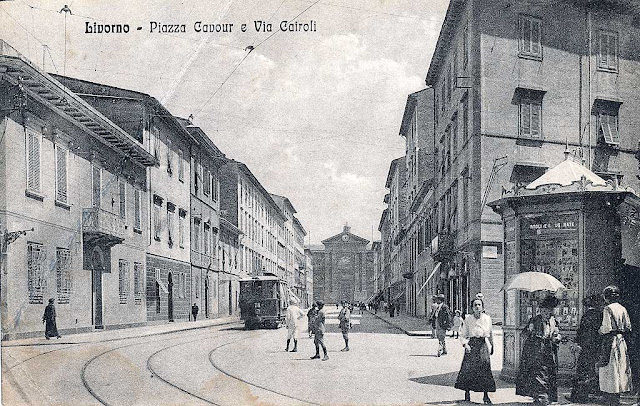











_10.jpg)
